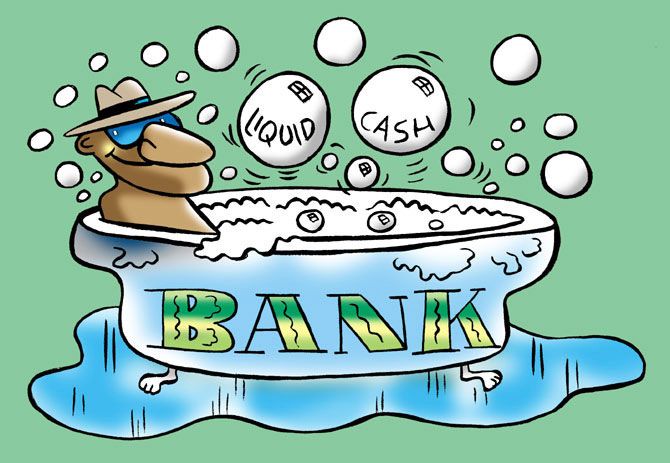Corporate indebtedness is now twice what it was before the global financial crisis; banks' bad loans ratio is 3.5 times higher, reports Krishna Kant/Business Standard
Illustration: Uttam Ghosh/Rediff.com
 Corporate India and banks are much less prepared for an economic slowdown than they were on the eve of the 2008 global financial crisis based on key ratios.
Corporate India and banks are much less prepared for an economic slowdown than they were on the eve of the 2008 global financial crisis based on key ratios.
The corporate debt-equity level is now twice that during 2007-2008, while corporate profitability during 2015-2016, as measured by return on equity, was half that in FY08.
Their debt servicing capability also shows a similar trend.
Ex-financials companies from the BSE 500 index universe reported a return on equity of 11.5 per cent in FY16, down from 22.1 per cent in FY08.
Banks are in an even worse position than they were on the eve of the global financial crisis in 2008.
At 8% of their advances, banks' non-performing loans are three-and-a-half times that in FY08, while total bad loans in absolute terms during FY16 was 11 times the corresponding figure in FY08.
The country's top 40 listed banks reported combined bad loans (on gross basis) of Rs 5.8 lakh crore at the end of FY16, against Rs 51,000 crore at the end of FY08.
Analysts say corporates could also face the heat from a sharp rise in household indebtedness in recent years.
Total household debt has tripled since March 2008 to nearly Rs 20 lakh crore at the end of FY16, against Rs 6.3 lakh crore at the end of FY08.
Retail loans, including loans from non-banking financial companies (NBFCs), amounted to 19.4 per cent of personal disposable income in FY16, against 16.8 per cent during FY08 and low of 14.2 per cent in FY10 for the companies in the sample.
Personal disposable income is the portion of national income that accrues to households and is defined by national income minus all government taxes and levies, savings of the public sector and profits retained by private corporate sector. It accounts for around 75% of India's gross domestic product currently.
As a result, households now spend a larger share of their disposable income on loan servicing (equated monthly instalments or EMIs) than any time during the recent past.
In this scenario, a decline in income or job losses from economic slowdown could result in disproportionate decline in consumer demand and even bad loan problem for banks and retail NBFCs.
Total household debt could be much bigger, as our sample only includes the loan book of NBFCs that are part of the BSE 500 companies and excludes unlisted NBFCs, including in-house financing arms of automakers.
The debt-equity ratio, interest coverage ratio and return on equity are calculated for the 389 BSE 500 companies, excluding banks and financials. Banking sector data for non-performing assets is 40 top listed banks.
Household debt is the sum of the retail loans such as home loans, auto loans, loan against property, credit card debt, education loans, gold loans and other loans to individuals for banks and NFBCs.
Analysts said the combination of higher corporate and household indebtedness could result in bigger pain for Corporate India and banks, if the cash crunch induced by demonetisation results in significant decline in corporate profitability in the forthcoming quarters.
"Corporates have much less cushion to absorb a sharp decline in profitability than in the past. A profit shock could translate into balance sheet issues for many companies resulting in more bad loans for banks. This will create a ripple effect in the economy prolonging the slowdown," said Dhananjay Sinha, head of institutional equity at Emkay Global Financial Services.
Interest payment was the fastest growing cost head for Corporate India in the past decade, as it absorbed 20.4% of all operating profit BSE 500 companies (ex-financials) during FY16, against 9.6% in FY08.
The country's top listed non-financial firms owed Rs 25.4 lakh crore to their lenders at the end of FY16, against Rs 7.2 lakh crore at the end of FY08.
Corporate debt-equity ratio (or leverage ratio) net of cash on books has doubled during the period to 0.63x, from 0.31x in FY08.
Some experts expect a quick bounce-back in corporate growth and profitability once the liquidity situation normalises without any collateral damage to the country's long-term growth potential.
"There could be some enduring pain for the construction-related sector in the medium-term, but the corporate sector would get back on its feet in FY18," says G Chokkalingam, founder-chief executive officer, Equinomics Research & Advisory.











